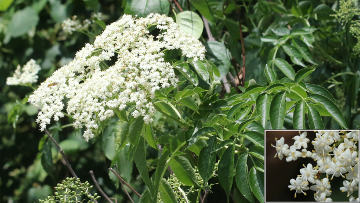Village News

PHOTO COURTESY OF GARRY KESSLER
Common elderberry in bloom
July 24, 2020, Page A6
NATURE NOTES
By Annie Reid
Westborough Community Land Trust
Elderberries for wildlife
Summer is the berry season in the wild, not only for people but especially for wildlife, from birds to mammals to pollinators and other insects. One of our more conspicuous wild berry-producers is elderberry, a large wetland shrub that blooms in large flat sprays of tiny white flowers in early summer. In late summer, these turn into flat, nodding clusters of tiny blue-black berries.
You might recognize a blooming elderberry shrub from a distance, due to the flat shape of its big flower clusters. (Most other shrubs that bloom in clusters of small white flowers have smaller, more rounded or dome-shaped clusters.) Elderberry has abundant dark green leaves, typically with seven long, pointed leaflets, but sometimes with 5-11. It thrives in full sun but tolerates shade. Look for it in moist areas, such as damp meadows, shorelines, stream banks, and roadside ditches. It can form thickets. You might even find it in someone’s yard, since it is sometimes planted as an ornamental or part of a garden to attract pollinators and birds.
The wild native shrub that you’ll usually see is common elderberry, also known as black elderberry (Sambucus nigra canadensis), but there’s also a European subspecies (Sambucus nigra nigra) that can grow to the size of a tree. Another, less common species is red elderberry (Sambucus racemosa), which grows in forests, has rounded flower clusters, and produces bright red fruit.
Are elderberries good to snack on? Not exactly. You might think they’d be good to eat if you’ve heard of elderberry wine or jelly, but the ripe berries have a taste often described as “rank,” and each one contains a large seed. As far as people are concerned, only the flowers (in fritters or pancakes) and the ripe berries are suitable as food. Note that the unripe berries and the plant’s leaves, bark, roots are toxic, due to chemicals related to cyanide.
It’s a different story for wildlife. Many birds – more than 40 species – feast on the berries, especially during migration season in late summer and fall. Robins and catbirds even beat the crowds and go for not-quite-ripe berries. You might spot resident wild turkeys, mourning doves, and pheasants eating the berries, as well as southbound rose-breasted grosbeaks, European starlings, veeries, and brown thrashers. The berries are also popular with foxes, mice, red squirrels, and woodchucks. Deer will eat the foliage.
As a native plant, elderberry provides housing or food for many native insects. Elderberry flowers don’t produce much nectar, but they attract bees, flies, and beetles that feed on pollen. The plant is also one of many hosts for caterpillars of a lovely giant silk moth, the cecropia moth (Hyalophora cecropia).
Thanks to preparation methods that eliminate its toxicity, such as drying or cooking the berries, elderberry has provided people with ingredients not only for food but also for traditional or folk medicine. Teas and syrups have been used as remedies for colds, flu, and fever. Washes and poultices have been used to treat skin problems. In other uses, parts of the plant have been used as an insect repellent, and berries have been used in a dye.
How can you best enjoy this plant? Spot blooming elderberry shrubs in June-July, and watch them in August-September to see birds and other wildlife.